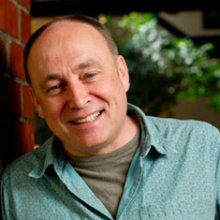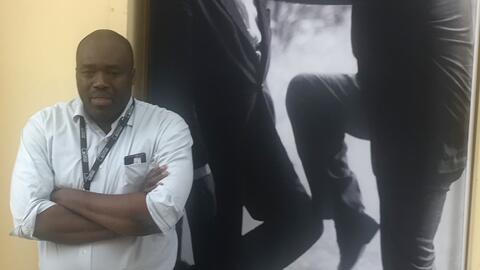
Mark Cosgrove Cinema Curator
on Mon 22 July 2019Archiving and restoring Africa's film heritage: Visions and Challenges
Posted on Mon 22 July 2019
Cinema Rediscovered founder and co-curator Mark Cosgrove sat down with Dr Aboubakar Sanogo, assistant professor of Film Studies at Carleton University in Ottawa, Canada and North American Secretary of FEPACI, to discuss the challenges and vision for African film heritage.
The 2019 edition of Il Cinema Ritrovato profiled the work of the African Film Heritage Project, a joint initiative between Martin Scorsese’s Film Foundation, UNESCO, Cineteca di Bologna and the Pan African Federation of Filmmakers (FEPACI) and featured two new restorations: Woman with a Knife (1969, Ivory Coast) by Timité Bassori and Muna Moto (1975, Cameroon) by Jean-Pierre Dikongué Pipa. During the festival Cinema Rediscovered founder and co-curator Mark Cosgrove sat down with Dr Aboubakar Sanogo, assistant professor of Film Studies at Carleton University in Ottawa, Canada and North American Secretary of FEPACI, to discuss the challenges and vision for African film heritage.
Mark Cosgrove: How did your relationship with the African Film Heritage Project, and Il Cinema Ritrovato develop.
Aboubakar Sanogo: I did my PhD on the History of Documentary in Africa. In my research I wrote about one of the first filmmakers from Tunisia called Albert Samama-Chikli (1872 – 1933). He was the son of a wealthy family who had access to the new technology at the turn of the 20th Century. He was into photography, X-ray, the first bikes, the first of many things that were happening in the late 1800s and at the beginning of the 1900s. He made the first shorts and feature in Tunisia in 1922 and 1924 which count as the first African fiction films. I was interested to know when I was in Tunisia if any of his family were alive. I stumbled across someone who knew his family and went to interview his granddaughter. She told me among many other things, that on the eve of Tunisian independence, Chikli’s wife, who was Italian, from Sicily in fact, took some of his camera equipment, films, and gave them to the Italian embassy in Tunisia so they would ship them to Italy and of all places to Bologna. I was already planning to go to Bologna, so I bought my ticket.
I had met Cecilia Cenciarelli in 2009 at FESPACO and they arranged for me to attend Il Cinema Rotrovato. I said to them "I am looking for Chikli” but they had never heard of him and informed me that they could not possibly have anything on/from him in their cinematheque, given that the latter was founded long after Tunisia's independence in 1956. I was heartbroken but asked them whether they would be interested in doing something on Chikli.I knew there were 3 or 4 films in France we could get. I went back to Canada and a year and a half later Bologna wrote to me and said "We’ve thought more about Chikli and we would like to work with you on a programme about him." We tried really hard to see if we could locate some of the films. Marianne Lewinsky who was the festival film researcher went to the UK and France to look. We knew Chikli was part of the French Film and Photography Unit in WW1 with Abel Gance. He filmed parts of WW1 in 1917/18 which the French Army film archive have. This formed the basis of the programme here.
Marianne had also found something with Lobster Films in France entitled Tuna Fishing in Tunis but not under Chikli’s name but rather under that of the Charles Urban Trading Company. Because it had a title that resonated with Chikli’s own La pêche au thon à Sidi-Daoud (which we believed lost at the time), the plan was initially to screen this Urban Film as part of the larger family of interest of Chikli’s. But given that Luke McKernan was working on Urban, she asked him to check whether it was indeed an Urban film or a Chikli film acquired by Urban. McKernan did find the title Tunny Fishing in Tunis in the Urban Catalogue. We were looking for Tuna fishing and thought maybe tunny/tuna. Tunny happens to be another way of saying of tuna. But how could we confirm that it was Chikli’s film? Chikli had taken some slides from the film. I think it had been commissioned by the Prince of Monaco, no less. McKernan scanned the pages of the Urban catalogue which included stills of the film. Incidentally, we had just received scans of stills/slides from La pêche au thon a Sidi Daoud from the Chikli family. By comparing the stills from both sides, we were able to match an image which featured an operator cranking a camera filming the 'matanza’ as it was called. That is all we needed. We had just discovered one of Chikli's oldest films from around 1905. This was a most exhilirating feeling. We were pushing the beginnings of cinema in Africa further back and back. We did a retrospective of Chikli’s work at the Festival in 2015. It was a major success.Since then, we decided to work together. We talked about potential avenues of collaboration. I am also involved in an institution called the Pan African Federation of Filmmakers (FEPACI). I am the North American representative. At the time, we were trying to work out a plan for film preservation and archiving. It’s one of the continent’s weak spots so we designed a plan to that effect. We knew Scorsese’s World Film Foundation were working in this area. They had already been doing things back in 2007 with Soulymane Cissé. In the discussions, Cissé suggested "well maybe you should think about African cinema". He got Cissé on the board and they started.
Because we are representative of African filmmakers, we wanted to do something more systematic, a way in which we decide which films should be part of the patrimony. We are working in partnership with the filmmakers, the Film Foundation's World Cinema Project and UNESCO to create the African Heritage Project.

(Dr Aboubakar Sanogo with Martin Scorsese at African Film Heritage Project signing)
MC: That was started in 2017?
AS: We launched it at FESPACO in 2017 and we did the official signing in New York with the DG of UNESCO and Scorsese. We have been working on restoring a number of African films. We’ve done four. In 2017, we did Med Hondo Soleil O (1970, Mauritania). He came to Bologna with the restoration. We try to do something every year. In 2018, we did Chronicle of the Years of Fire which was the first African film to win the Palme d’Or in 1975 directed by Algerian filmmaker Mohammed Lakhdar-Hamina. For this year, we have done two films: Woman with a Knife (1969, Ivory Coast) by Timité Bassori and Muna Moto (1975, Cameroon) by Jean-Pierre Dikongué Pipa. Because the films are restored here in Bologna at L'Immagine Ritrovata, they are then premiered at one of three festivals: Il Cinema Ritrovato, Cannes or FESPACO. The two most recent ones premiered at FESPACO at Ouagadougou.
MC what are the challenges of restoring African cinema?
AS: Our cinema history, the memory of our cinema is a diaspora. Our film history is a diaspora. There are several stages around film history: the colonial moment; the kind of policy the respective colonial country had in relation to culture - the Portuguese, the French, the British - but also many of our countries got their independence during the cold war. Many of the countries were Communist/leftist-orientated and they followed that political line.
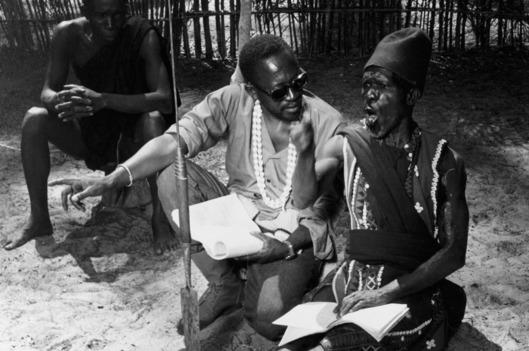
(Still from the documentary Sembene! 2015 Dir. Samba Gadjigo and Jason Silverman, . Photo: Sundance Institute)
MC: This is why directors such as Souleymane Cissé / Ousmane Sembène for example both trained in Moscow?
AS: Yes, but there were different reasons. Sembène was already a well-known writer, a member of the communist party and so he was part of that international grouping of communist writers. That was his axis and access to Moscow. For Cissé, this was partly because his country was left orientated and had very good links with the Soviet or let’s say the Eastern bloc so the filmmakers were trained in Russia or Yugoslavia, for example. He went several times. Their student films for example are definitely there. As part of co-productions or whatever relationship the states had with each other, many of the films were post-produced there. We have a very interesting case with Guinea, the first Francophone country to detach itself in 1958. They decided not to join the French Union when Charles De Gaulle went to try create a French Commonwealth. Ahmed Sékou Touré – the country’s first President - said “No, we want independence today". So, to punish him severely, the French cut his links to the Western world, the banking system, etc. He veered more radically towards the Soviets and their allies. That decided the fate of Guinean cinema, which was one of the first to have studios and facilities. You can find many of the films from Guinea in those countries. We have a list of 147 films which were made between 1960 and 1984 and we know there are a number of films in Poland, Soviet Union, some in China and we know the titles. Part of the work is to go to each of those countries and have conversations, see if we can find and get access to them. That’s one challenge.
The second, in Western Europe and around the world there’s been an evolution in the technology of cinema with digital now and so, a lot of analogue is gone. Most of the labs that worked on the films have gone. We are very apprehensive about the fate of our films. Where did they send the films? Some hopefully will have gone to the National Archives that existed. Some may have dumped them. We really have no idea. If they have been sent to, for example, a French archive, it would be expected that they would prioritise their own film heritage. We are in a race against time right now trying to recuperate and locate these films. Even if we do not have all the facilities in Africa at the moment, at least let us find where they are and deposit them somewhere until we can work on the issue of creating an infrastructure for archiving.
Two major challenges; not to mention the question of funding. Restorations are very expensive ranging from $100K to $300K which is a lot. We have those challenges with filmmakers themselves. Of course, why would you put $300K into a film that I have already made when I have 15 scripts waiting to be made. So, we have those arguments.
MC: There is an irony that in this digital era people tend to think that everything is available. They do not realise that film is very fragile. As you say, there is this race against time with film specifically but also technologies are always evolving.
AS: People always forget that when a new technology comes along, it is not a direct conversion from the previous form. There is always a difference in transfer plus in a commercial environment, the smaller lesser screened films can suffer. It is a global phenomenon but even more amplified in the case of African film heritage.
MC: Are there plans to have an archive somewhere in Africa?
AS: I mentioned earlier that we are coming up with an archival plan. Restoration is really only one aspect. Some of the biggest challenges are around the need for an archival infrastructure in every single country across the continent, then country by country at the regional level and also at the continental level. Right now, we are working on convening something called the Estates General of Film Archiving in Africa to bring archivists from the 54 countries together; first of all, to get to know one another, to know what the state of film preservation is in each of these countries. After that, we plan to create an association of film archives to lobby our governments and UNESCO as well as other partners interested in working with us to really help set up an infrastructure to immediately stop the loss of existing work that are being affected by "vinegar syndrome". So different levels of sophistication as well…
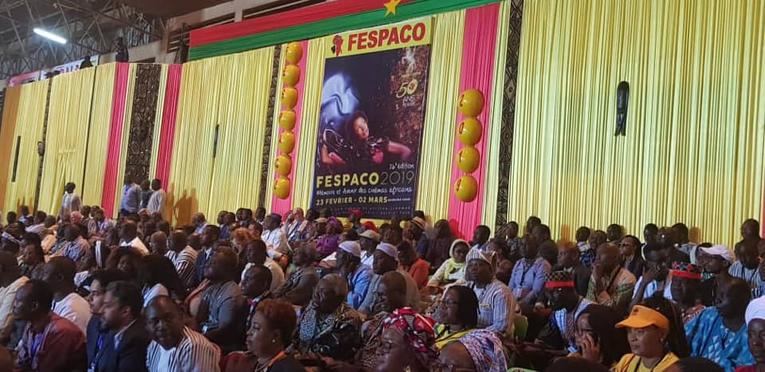
(Panafrican Film and Television Festival of Ouagadougou - FESPACO, 2019)
MC: Festivals play an important part in raising awareness about film culture. We’re here in Bologna and Il Cinema Ritrovato where histories of film get re-presented to audiences. I want to come to FESPACO which celebrates its 50th year. How important has it been and the role that it plays in relation to archiving.
AS: There are several ways of looking at it. First of all, FESPACO is an archive in itself. As an institution, it is an archive of the dream of African cinema, of the desires of the filmmakers and the brilliant ideas they came up with - to create a sustainable African cinema; and in terms of articulating what a politics of cinema is, what a politics of culture is and the relationship between culture and politics through cinema. They articulated in a really sophisticated way what that meant both theoretically and critically. Their big problem was that the founders were filmmakers, so the gap between theory and implementation was very wide and also because the awareness of cinema is more or less heightened depending on the country in which you are. So obviously in Burkina Faso, you have a history of awareness. In Senegal and Ivory coast, you do. In other countries, people couldn’t care less about cinema so there are different levels of discourse in different countries. FESPACO is an archive of ideas; a freed zone, a liberated zone because when these filmmakers were making their films, they could not show them in their countries because distributors were receiving dumped Hollywood films for cheap and they didn’t see why they had to pick up local filmmakers. It didn’t make commercial sense to them. The filmmakers got together and said, we have to create our own festival where we can show our films to our people. They created one in Carthage in 1966 and then one in Ouagadougou in 1969, precisely to have an encounter with the African audience. That’s how FESPACO began.
In addition to showing films, filmmakers strategised a lot producing discourses around cinema and around African Cinema. All the plans about what the dream of African cinema should be including preservation were already articulated, at least many of them in various forms so FESPACO was definitely a place for political and ideological debate. FESPACO participated majorly in the writing of the history of African Cinema. There is no doubt about that. Sometime around the late 1980s, early 1990s they decided to take forward the idea of preservation. This was under the aegis of FEPACI, the Pan African Fedration of Filmmakers. They are an association of filmmakers; they are not a country; they are not a ministry. They had been discussing since at least the early 1970s. They said: “we need to at least have a place that we can have an archive” so, the Cinematheque Africaine de Ouagadougou was officially launched in 1989 during the 20th anniversary of FESPACO and it inaugurated its preservation space in 1995 during the celebrations of the centennial of cinema (1995). Because Ouagadougou was already the place where FESPACO was held since 1969 and they had the physical and legal headquarters of FEPACI since 1985. They also had a regional film school in 1979 co-created with UNESCO and there were a number of exhibition and distribution companies that had existed around the city. They felt like it was the natural place to bring up the question of archiving. In 1995, we officially launched the Cinémathèque Africaine de Ouagadougou. The idea was that they asked all filmmakers to deposit a copy of their film there so that African researchers and young African filmmakers could access and take inspiration from their film culture and heritage.
They gave the idea to the government of Burkina Faso who incorporated it within the legal framework of FESPACO and provided it with civil servants and technicians to run it and a budget. However, the country is not very rich and there are all kinds of challenges: the weather is not very helpful with 45 degrees under the sun throughout the year and archival technology created for temperate climates.
Running this Cinémathèque is now part of FESPACO’s role. This year as part of the 50th anniversary of FESPACO, I organised the equivalent of Il Cinema Ritrovato and Cannes Classics' section of African film for the festival. We showed 23 films most of them restored through different entities including World Cinema Foundation, the Swiss and the French. It was an absolute success. The festival now has this idea to create a heritage section.
MC: It is a fantastic experience when audiences respond to older films, to seeing these images again.
AS: The great thing is that the filmmakers come and even with those who have passed away there are people who have worked on their films still around. I was able to bring together people to produce new knowledge on the films as they had never been interviewed about their experience of making the films. I showed Djibril Diop Mambéty’sTouki Bouki and Hyènes and some of the people who worked on the sets were there.
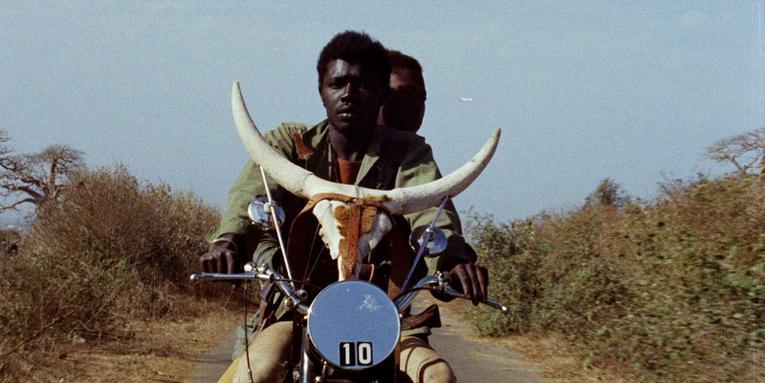
(Magaye Niang and Mareme Niang in Touki Bouki, 1976, Dir. Djibril Diop Mambety)
MC: I wanted to ask about the young generation of African filmmakers, how are they responding?
AS: The young African filmmakers are at a really important crossroad. There has never been more of a passion for making films than now in terms of sheer numbers. When Sembène, Hondo and Cissé were making their films, the technology was heavy. Now with digital, everyone has access to the technology. What they don’t have access to is the history unfortunately or they are not aware of the history. Even when they have access to the history, it’s a particular history. It’s the Euro/American canon. Part of our plan with the films that we are restoring is to have a mandatory screening at every single film school that trains African students in cinema. We will start in Africa of course; in Ouagadougou, in Morocco, in Togo. We will send them copies of the film so that they will integrate them into the syllabus. No African filmmaker can take a camera without seeing a Med Hondo or Sembène or Cissé. Because when you look at the films today…honestly?!
MC: It’s a very real challenge?
AS: It is a challenge for them more than ever as well. You do have to cut them a bit of slack because today in the geopolitics of cinema, you cannot make a decent sized film without going through this dreadful thing called the workshop system. They take your script, your film and then workshop it, re-write then re-write.
MC: Always the worst question I find is “who is the film’s audience?”
AS: But also, “whose film is it?” as far as I’m concerned. The filmmakers get trapped. People give tiny amounts of money that is why it is so scandalous. They give you $30K here, $40K there. They deform your scenario, the idea, because the film now has to bring in a return. If Sembène and the others had to go through this, you wouldn’t have had Black Girl; you wouldn’t have had Muna Moto, Baara etc
MC: With that older generation, there was an informing politics of the post-colonial moment and defining self-identity. Is there an informing politics of the younger generation? Are there issues they are trying to communicate beyond a cinema of genre and entertainment?
AS: We have to be mindful of the fact that when that older generation were making their films, the world was different. There was a bipolar world and ideological tendencies went between the two. In the case of Sembène, he was left leaning. In some ways, there was a clear language for the politics at the time: decolonisation, socialism, anti-imperialism, anti-capitalism. And also of course creating a new African culture and identity. We are at a completely different historical juncture with globalisation or post-globalisation even. The picture is more murky, for everyone!
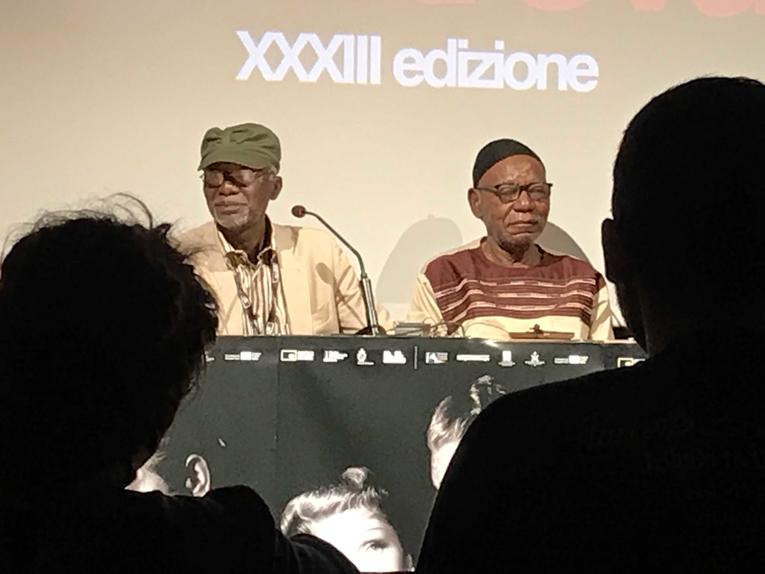
(Filmmakers Soulymane Cissé and Jean-Pierre Dikongué Pipa at Il Cinema Ritrovato)
MC: I was thinking is it about activism? Global activism?
AS: But there is no over-riding ideology. In the days of ideological socialism, you were referred to as an activist when you had good intentions trying to change the world but you were not informed ideologically. You were not a revolutionary, you were an activist. That is what we have right now, indeed, people are trying to do things but the current intellectual level of thinking of a set of politics of this moment has not yet been sufficiently synthesised to really produce a master narrative that clearly places people here or there. Capitalism is obviously the global norm. At the same time, its limitations are coming out globally in particular ways and taking several forms. The colonial argument in the past meant that Europe looked at itself as the future of Africa, something that Africans should aspire to. Increasingly, in the early 21st Century in fact, Europe is going in the direction Africa travelled two or three decades ago. We, for example experienced the hardship of the Global monetary system in the 80s and 90s – “you have to tighten your belt, that’s the norm if you want to develop”. Africa didn’t have the powerful political voice to actually make the world hear the intensity of the suffering, there was no media so they were not heard.
Now that structural adjustment has come to the West, we see that the past of Africa has become the future of Europe but with the difference that Europe and the North have amplifying resources like BBC and CNN so that when the population starts to react, it is filmed like it is the first time it is happening in human history! We know that story - we’ve been through it. When you look at Greece for example, well we were Greece three decades ago.
We are all in the same boat in that sense and that is why films like Med Hondo’s have become extremely important because they register some of these undercurrents that have only become legible. They have become real avant-garde films in that sense.
MC: I was at the Ghana Pavilion at the Venice Biennale which was designed by architect David Adjaye and had work by filmmaker/artist John Akomfrah. I wondered to what extent we are seeing a growing relationship between the African diaspora and I emphasise the quotes their ’home’ countries?
AS: It depends on what you call diaspora - they are many and varied. The more interesting question in relation to archiving is that working with David Adjaye for example would be fantastic for other reasons. In FEPACI we are interested in looking at the physical building that hosts the films. When colonialism came, it delegitimised our own architectural traditions. Architectural research has revealed that, in fact, adobe is better at keeping coolness than bricks and mortar. So, we would precisely like to work with someone like David turning his high level of technological thinking to these objects to really think through how we can perhaps even reinvent the physical infrastructure of archiving. Archiving requires energy. We are very challenged across the continent for electric energy but we are the continent of the sun. We come from the sun as Med Hondo said, Soleil O means we come from the Sun. The idea is to really capture that energy and create our own conditions for the labs. So, there is a research and development wing to what we are doing as well which is part of the whole work of training, archivists, technicians etc. It is a whole ‘dispositif’ to use a Foucauldian term - the whole apparatus of archiving from the intellectual conceptual dimension to the physical infrastructure, exhibition and pedagogical. It is the entire thing we are trying to look at.

